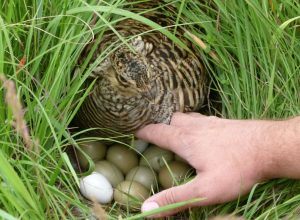Attwater’s Prairie-Chicken Captive Breeding Facility
An Endangered Species Recovery Effort in Oklahoma by Sutton Avian Research Center
The Attwater’s prairie-chicken is one of the most endangered birds in North America. Dangling on the edge of extinction for decades, this grassland grouse once inhabited six million acres of prairie along the Gulf Coast from the Bayou Teche area in Louisiana, southwest to around Goliad, Texas, and extending some 75 miles inland. As grasslands were consumed by human settlements, industries, agriculture, brushy vegetation, and possibly pesticide use on rice crops, as well as hunting, the estimated population of close to one million birds about a century ago plummeted precipitously. It was listed as endangered in 1967, and by 1996 only 42 birds were left in the wild.
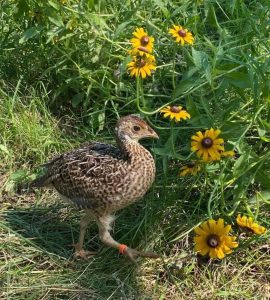
Attwater’s Prairie-Chicken in field.
The Sutton Center participates on a project to produce Attwater’s prairie-chickens in captivity for subsequent release into the wild. Prior to acquiring the critically endangered Attwater’s prairie-chicken, Sutton gained experience with husbandry methodologies by captive breeding the non-endangered greater prairie-chicken.
In May 2015, 41 eggs were collected from greater prairie-chicken nests located during one of Dr. John Toepfer’s field research project in the Nebraska Sandhills. These hens later recycled and produced second wild clutches. Forty eggs hatched and a captive breeding flock was established to work on designs and methods for raising and releasing prairie-chickens. In 2017 and 2018, we returned greater prairie-chickens to the area where the eggs had been collected, and tracked them to compare their success with their wild-hatched kind. We found that survival was not quite as good but they were active on booming grounds, females moved considerable distances as expected during the breeding season, and they produced young.
In spring 2019, 58 fertile Attwater’s prairie-chicken eggs were transferred to Sutton Center from zoos in Texas. These eggs represent the origin of Sutton Center’s present flock, and chicks are now raised and transferred for release every year. Our flock and facilities have grown to the point where the greater prairie-chickens have been phased out and our captive breeding efforts are currently focused only on the Attwater’s prairie-chicken at this dedicated facility 9 miles from Sutton Center’s headquarters.
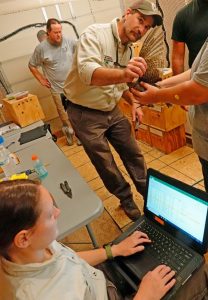
APC Processing for release.
Captive production of the Attwater’s prairie-chicken is essential to provide birds and re-establish sustainable populations in the wild. Sutton Center collaborates with three other facilities that raise the Attwater’s prairie-chicken for release: Houston Zoo, Caldwell Zoo, and Fossil Rim Wildlife Center in Texas. All these individual flocks are carefully managed to ensure optimal genetic diversity. Currently, captive produced offspring are released annually at the Attwater Prairie Chicken National Wildlife Refuge in Texas, as well as on private ranch properties in Goliad County, Texas.
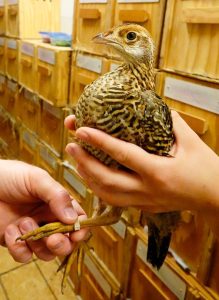
APC ready for transfer to wild.
In the wild, the Attwater’s prairie-chickens have a relatively short lifespan (2-4 years). Loss of habitat and short lifespan are important factors that limit the rate of population expansion. Other limiting factors include severe weather events, such as drought and hurricane effects, as well as tree encroachment and the invasive red imported fire ant. The captive breeding of disappearing prairie-chickens or other grouse will not in itself solve the problems that these birds are currently facing. This must be accomplished in combination with habitat reclamation, management, and conservation efforts. We hope that what we learn from the Attwater’s prairie-chicken breeding program will also be useful in achieving higher survival and reproduction in the wild of other captive bred Galliformes like bobwhite quail, lesser prairie-chickens, and other grouse as needed.
The prairie-chicken breeding facility would not have been established if it were not for the support and funding from the Mohamed bin Zayed Species Conservation Fund and the U.S. Fish & Wildlife Service. We have many more to thank for their collaboration and advice. Key partners include the Attwater Prairie Chicken National Wildlife Refuge, the National Fish & Wildlife Foundation, Dr. Ellen Dierenfeld, Dr. Al Hollister, John Seabury, Kim Huckaby D.V.M. and her staff at Bent Arrow Veterinary Hospital, the members of the Attwater’s Prairie-Chicken Recovery Team, Houston Zoo, Fossil Rim Wildlife Center, Caldwell Zoo, The Nature Conservancy, the Emirates Center for Wildlife Propagation, Oklahoma Department of Wildlife Conservation, Texas Parks & Wildlife Department, Nebraska Game and Parks Commission, and the Lackaff Ranch. Corporations and supporters who helped with purchase of property to build the facility include Chapman Foundation, Devon Energy, NatureWorks, Harold & Sandy Price, Sarkeys Foundation, Williams, and Joseph H. Williams. Also thank you to interns, volunteers, and supporters who are helping our staff along the way!
Dr. Toepfer tracking Greater Prairie-Chickens in Nebraska to collect eggs for the breeding facility.

Developing eggs in a contact incubator. Candling of egg to determine health of embryo. Pipping and hatching eggs. Newly hatched chicks snuggle in towels against a heating pad.
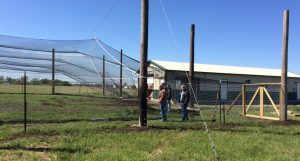
A netted enclosure protects the captive prairie-chickens as well as allows them to live in natural habitat, shown here in early spring when the grass was short.
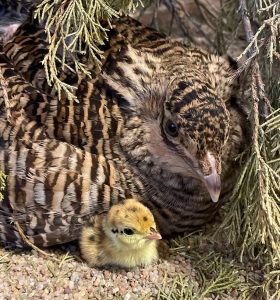
Attwater’s Prairie-Chicken with Chick.
This video produced by Friends of Attwater Prairie Chicken Refuge provides some background information about Attwater’s Prairie-Chickens and the work underway to save them.


